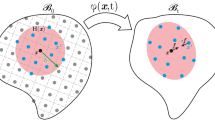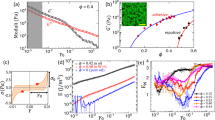Abstract
The debonding of pressure sensitive adhesives (PSA) is a classical example of the difficult and unsolved issue of fracture in soft viscoelastic confined materials. The presence of a complex debonding region where the adhesive undergoes cavitation and the very large strain of a spontaneously formed fibrillar network has defied many modeling attempts over the past 70 years. We present here a novel technique to provide an accurate measurement of the local large strain response of the fibrillar debonding region during the steady-state peeling of a well known commercial adhesive over a wide range of peeling velocity and angle. The technique is based on high resolution imaging of the debonding region during peeling and is coupled to a cohesive zone modeling of the adhesive interaction between the flexible tape backing and the rigid substrate. The resulting database provides a strong ground for validating and further developing models (Villey et al. in Soft Matter 11:3480–3491, 2015) aiming to capture the effects of both geometry and non-linear adhesive rheology on the exceptional adherence energy of PSAs.










Similar content being viewed by others
Notes
This PSA is made of an acrylic adhesive layer of thickness \(a_0 \simeq 20~\upmu \)m coated on a UPVC backing of comparable thickness, Young’s modulus \(E\simeq 2.9\) GPa and width \(b=19\) mm.
We find that this modulus changes significantly between different rollers, and even between distant portions of the same roller, with an average value \(EI=(3.7 \pm 1.7)~10^{-8}\) N m\(^2\). This value agrees with the estimate that can be made from the expression \(EI=Ebh^3/12\), where E is the Young’s modulus and h the thickness of the tape backing, using an independent tensile test giving \(Ebh = 1100 \pm 200\) N and microscopic observations of the thickness providing \(h=20\pm 5\,\upmu \)m. An attentive study reveals that the variations in bending modulus EI can actually be attributed to small variations of the tape backing thickness of amplitude \(\pm 3\) µm, since \(EI\propto h^3\). In any case, in the present study the bending modulus EI will enter the problem only through the parameter \(r=\sqrt{EI/F}\), which will be directly measured for each experiment through elastica fits of the peeled tape outside of the debonding region.
The validity of this assumption is limited to the inextensible tape approximation of our model, that follows the arguments provided in Sect. 3.
Multiplying Eq. 7 by \(\alpha '\) and integrating from 0 to \(l_s\) yields
$$\begin{aligned} \frac{8FX^2}{\left( 1+X^2\right) ^2}&+F\left[ \cos (4\arctan {X})-\cos \theta \right] \\&-\bar{\sigma } b \int _0^{l_s}\left[ \cos \left( \alpha (s)\right) \int _s^{l_s}\sin \left( \varphi (t)\right) dt\right] {\alpha '(s)} ds\\&-\bar{\sigma } b \int _0^{l_s}\left[ \sin \left( \alpha (s)\right) \int _s^{l_s}\cos \left( \varphi (t)\right) dt\right] {\alpha '(s)} ds=0. \end{aligned}$$After trigonometric simplifications of \(\cos (4\arctan (X))\) and integration by parts of the two integrals, we get
$$\begin{aligned} \frac{F}{b}\left( 1-\cos \theta \right)&=\bar{\sigma }\int _0^{l_s}\left\{ \sin \left( \alpha (s)\right) \sin \left( \varphi (s)\right) \right. \\&\quad \left. +\,\left[ 1-\cos \left( \alpha (s)\right) \right] \cos \left( \varphi (s)\right) \right\} ds. \end{aligned}$$The integrand can be rewritten as
$$\begin{aligned} \sin \varphi \sin \alpha +\left( 1-\cos \alpha \right) \cos \varphi&=\frac{\left( y+a_0\right) \frac{dy}{ds}+\left( s-x\right) \frac{ds-dx}{ds}}{\sqrt{(y+a_0)^2+(s-x)^2}}\\&=\frac{da(s)}{ds} \end{aligned}$$where \(a(s)=\sqrt{(y+a_0)^2+(s-x)^2}\) is the length of the fibril attached to the tape backing at curvilinear position s. This finally leads to Eq. 12. One can also demonstrate Eq. 12 by computing the work associated to a small advance of the peeling front (see Online Resource 2).
Once we know \(\alpha (s)\), \(l_s\) and \(s_0\) , \(a_f\) can be determined by Eq. 15. Curvilinear abscissa is eventually redefined as \(s\rightarrow s-s_0\) after the fit, in order to set the beginning of the cohesive zone to \(s=0\).
The bias gets larger for the largest angle \(\theta = 150^\circ \), which will be discussed later.
The evaluation of the average strain rate requires the calculation of the temporal dependence of the length a(t) of a typical fibril during the peeling. We should thus operate a change of reference frame from the one of the laboratory (where the bending profile is steady and identified by our measurements of \(\alpha (s)\)) to the local reference frame of the substrate. The evolution of the bending profile in time in the local reference frame should be described by another slope function \(\beta (u,t)\) expressed in terms of the material curvilinear abscissa u. Since the substrate is moving at the same velocity as the peeling velocity V, the two bending functions are related by \(\alpha (u+Vt)=\beta (u,t)\). From the logarithmic strain \(\varepsilon (s)=\ln \left( a(s)/a_0\right) =\ln \left( \sqrt{(s-x)^2+(y+a_0)^2}\right) -\ln (a_0)\) of the fibril attached at position s in the laboratory reference frame, we can then compute the local strain rate as \(\dot{\varepsilon }(s)=\frac{1}{a(s)}\frac{da}{ds}\frac{\partial s}{\partial t}=\frac{V}{a(s)}\frac{da}{ds}\), which after integration results in Eq. 18.
References
Amouroux N, Petit J, Léger L (2001) Role of interfacial resistance to shear stress on adhesive peel strength. Langmuir 17:6510–6517
Barquins M, Ciccotti M (1997) On the kinetics of peeling of an adhesive tape under a constant imposed load. Int J Adhes Adhes 17:65–68
Chiche A, Dollhofer J, Creton C (2005) Cavity growth in soft adhesives. Eur Phys J E 17:389–401
Cortet PP, Ciccotti M, Vanel L (2007) Imaging the stick-slip peeling of an adhesive tape under a constant load. J Stat Mech Theor Exp 2007:P03005
Cortet PP, Dalbe MJ, Guerra C, Cohen C, Ciccotti M, Santucci S, Vanel L (2013) Intermittent stick-slip dynamics during the peeling of an adhesive tape from a roller. Phys Rev E 87:022601
Creton C, Ciccotti M (2016) Fracture and adhesion of soft materials : a review. Rep Prog Phys 79:046601
Creton C, Hu G, Deplace F, Morgret L, Shull KR (2009) Large-strain mechanical behavior of model block copolymer adhesives. Macromolecules 42:7605–7615
Dalbe MJ, Santucci S, Cortet PP, Vanel L (2014a) Strong dynamical effects during stick-slip adhesive peeling. Soft Matter 10:132–138
Dalbe MJ, Santucci S, Vanel L, Cortet PP (2014b) Peeling-angle dependence of the stick-slip instability during adhesive tape peeling. Soft Matter 10:9637–9643
Dalbe MJ, Cortet PP, Ciccotti M, Vanel L, Santucci S (2015) Multiscale stick-slip dynamics of adhesive tape peeling. Phys Rev Lett 115:128301
Deplace Creton C (2009) Fine tuning the adhesive properties of a soft nanostructured adhesive with rheological measurements. J Adhes 85:18–54
Derail C, Allal A, Marin G, Tordjeman P (1997) Relationship between viscoelastic and peeling properties of model adhesives. Part 1: cohesive fracture. J Adhes 61:123–157
Derail C, Allal A, Marin G, Tordjeman PH (1998) Relationship between viscoelastic and peeling properties of model adhesives. Part 2: the interfacial fracture domains. J Adhes 68:203–228
Gent AN, Hamed GR (1977) Peel mechanics for an elastic-plastic adherend. J Appl Polym Sci 21:2817–2831
Gent AN, Petrich RP (1969) Adhesion of viscoelastic materials to rigid substrates. Proc R Soc A 310:433–448
ISO 8510-1 (1990) Adhesives—peel test for a flexible-bonded-to-rigid test specimen assembly—part 1: 90 degree peel
ISO 8510-2 (2006) Adhesives—peel test for a flexible-bonded-to-rigid test specimen assembly—part 2: 180 degree peel
Kaelble DH (1959) Theory and analysis of peel adhesion: mechanisms and mechanics. Trans Soc Rheol 3:161–180
Kaelble DH (1960) Theory and analysis of peel adhesion: bond stresses and distributions. Trans Soc Rheol 4:45–73
Kaelble DH (1965) Peel adhesion: micro-fracture mechanics of interfacial unbonding of polymers. Trans Soc Rheol 9:135–163
Kendall K (1975) Thin-film peeling-the elastic term. J Phys D Appl Phys 8:1449–1452
Lakrout H, Sergot P, Creton C (1999) Direct observation of cavitation and fibrillation in a probe tack experiment on model acrylic pressure-sensitive-adhesives. J Adhes 69:307–359
Lindner A, Maevis T, Brummer R, Lühmann B, Creton C (2004) Subcritical failure of soft acrylic adhesives under tensile stress. Langmuir 20:9156–9169
Lindner A, Lestriez B, Mariot S, Creton C, Meavis T, Lühmann B, Brummer R (2006) Adhesive and rheological properties of lightly crosslinked model acrylic networks. J Adhes 82:267–310
Love AEH (1944) A treatise on the mathematical theory of elasticity. Dover Publications, New York
Niesiolowski F, Aubrey DW (1981) Stress distribution during peeling of adhesive tapes. J Adhes 13:87–98
Villey R, Creton C, Cortet PP, Dalbe MJ, Jet T, Saintyves B, Santucci S, Vanel L, Yarusso DJ, Ciccotti M (2015) Rate-dependent elastic hysteresis during the peeling of pressure sensitive adhesives. Soft Matter 11:3480–3491
Yarusso DJ (1999) Quantifying the relationship between peel and rheology for pressure sensitive adhesives. J Adhes 70:299–320
Acknowledgements
We thank B. Bresson and L. Olanier for their help in the conception of the experiments. We thank E. Barthel, M.-J. Dalbe, S. Santucci, L. Vanel, and D. Yarusso for fruitful discussions. This work has been supported by the French ANR through Grant #12-BS09-014.
Author information
Authors and Affiliations
Corresponding author
Electronic supplementary material
Below is the link to the electronic supplementary material.
Rights and permissions
About this article
Cite this article
Villey, R., Cortet, PP., Creton, C. et al. In-situ measurement of the large strain response of the fibrillar debonding region during the steady peeling of pressure sensitive adhesives. Int J Fract 204, 175–190 (2017). https://doi.org/10.1007/s10704-016-0171-1
Received:
Accepted:
Published:
Issue Date:
DOI: https://doi.org/10.1007/s10704-016-0171-1




